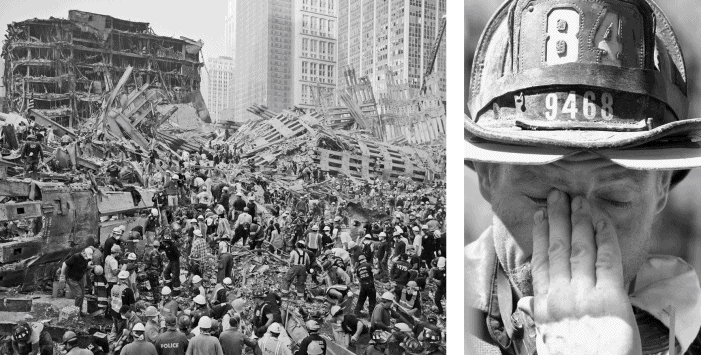Collateral Damage
John Zazulka was one of the lucky ones on September 11, 2001. Just a few weeks before terrorists crashed commercial jet planes into the World Trade Center, John, a firefighter at a Staten Island firehouse, had been offered a transfer to a special unit that responds to dangerous situations in New York City. It was an appealing offer, and John was well trained for that type of work. Yet he had recently promised his colleagues he would not leave them for another job, so he recommended someone else. That person, as well as 34 others John knew, died on September 11 while trying to rescue people inside the collapsing Twin Towers.
In the months after the attacks, John spent a lot of time in the rubble (“the pit”), digging for the remains of the dead (Figure 13.1). In a New York Times Magazine story about the families of the surviving firefighters (Dominus, 2004), Rudy Sanfilippo, the Manhattan trustee for their union, had this to say:
All those months at the pit . . . changed our lives and made our lives seem uncontrollable. You work and you work, and the best thing you can do is call a widow to say we found the tip of your husband’s pinkie? We lost control at the site, and we lost control at home. In both places we were doing the best we could, and it wasn’t sufficient. (p. 39)

FIGURE 13.1 Devastation at Ground Zero. After the events of September 11, 2001, the firefighters and other rescue workers who dug through the rubble of the Twin Towers faced day after day of emotional strain as they recovered the bodies of the dead. How do you think this experience might have affected their families?
Family strife and marital discord were common in the homes of the surviving firefighters after September 11. The number of people requesting couples counseling tripled, and John and his family were among them. Married for 18 years, John and Susan had four children. A year after the attacks, John announced he was unhappy and was leaving the marriage. The New York Times story quoted Susan’s reaction to the news: “ ‘Of course he was unhappy. Look what he’d just been through’” (Dominus, 2004, p. 38).
But John’s unhappiness was not the only reason he had decided to end their marriage. He had fallen in love with another woman. Debbie Amato was a widow whose husband, also a firefighter, had been killed in the line of duty on 9/11. She and John met and got to know each other at the many funerals, memorials, and ceremonies that took place in the months following the attacks.
It may seem unlikely that a firefighter who survived would become involved with the widow of one who perished. In fact, the New York City Fire Department knows of several triangles involving married firefighters and the widows of firefighters who died on September 11 (Hill, 2004). Susan, who came to feel like a widow even though her husband survived, sees this as evidence that her marriage was another victim of the attacks. “Her personal disaster, she seems to believe, is part of the bigger national tragedy” (Dominus, 2004, p. 40). John, however, failed to see the connection. He claimed he was never happy in the marriage and that the attacks were merely “a wake-up call.” And what about the theory that his attraction to the widow of another firefighter is a sign of some sort of “rescue complex”? “ ‘No, that’s not it,’ John said, looking at Debbie. ‘It’s the other way around. She saved me’” (p. 40).